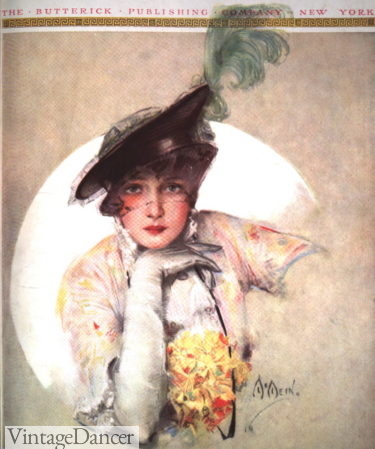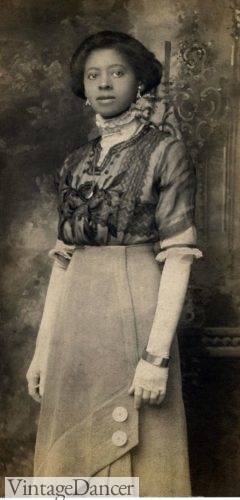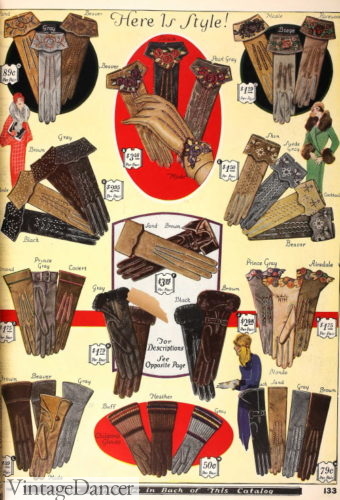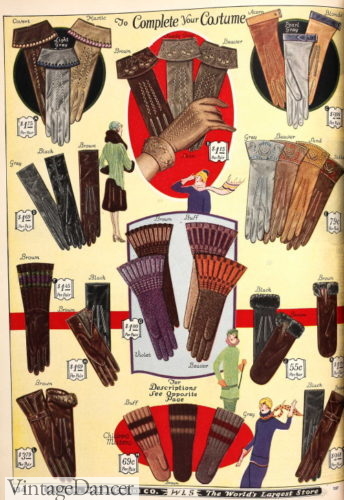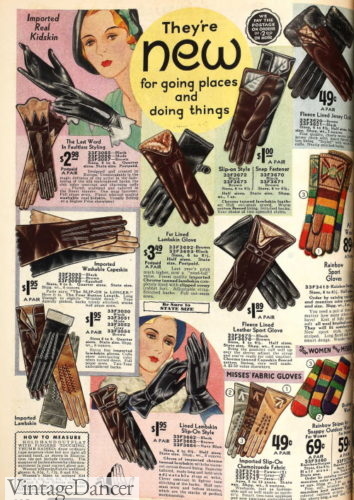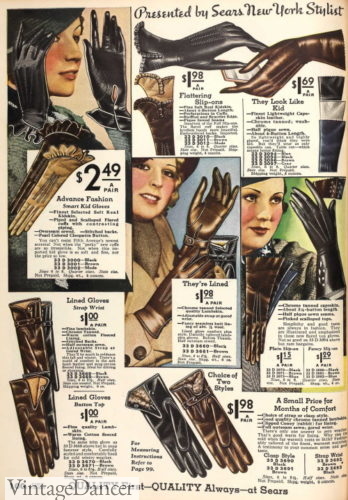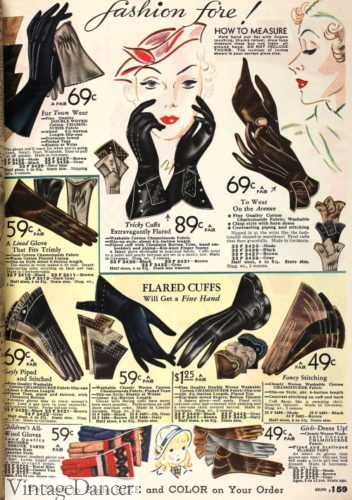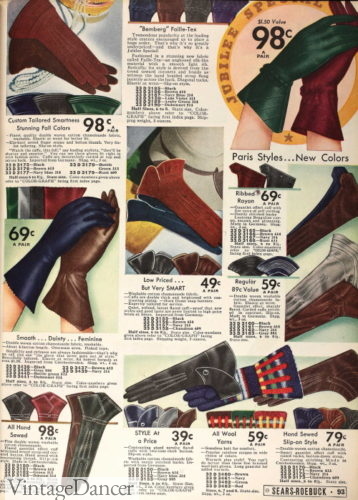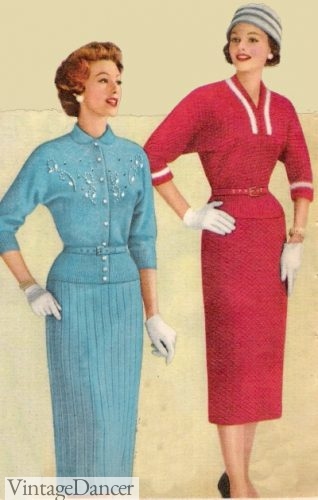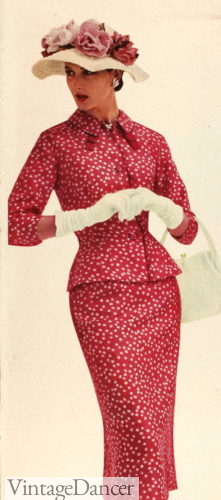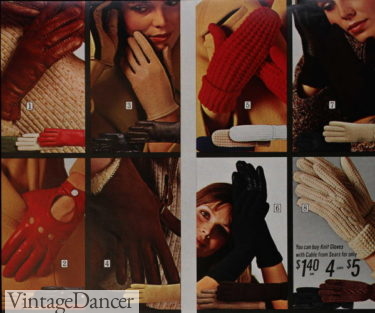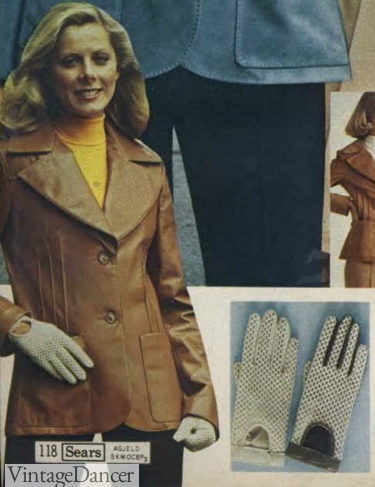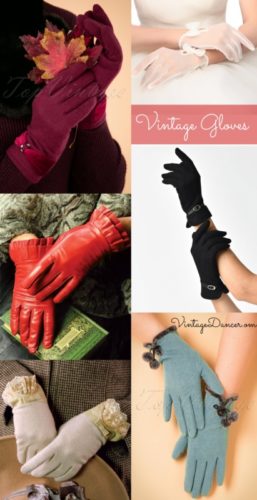Can you imagine having to wear gloves every time you left the house? Even in the summer? While gloves are worn only for warmth these days, they were an absolute necessity up until the mid-twentieth century. Both of the World Wars contributed to the vintage glove’s demise, as well as the new, more independent lifestyle for women.
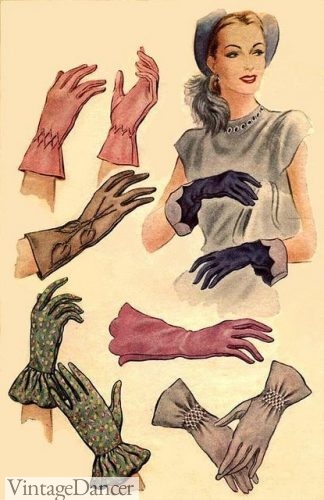
1950s gloves
Vintage Gloves with Purpose
Prior to the 20th century, gloves could symbolize a woman’s class or, in the case of gloves, hide her class status. A wealthy woman’s hands were pale, smooth, thin, and graceful. A working woman or homemaker’s hands were thick, rough, scarred, and tan. When she wore gloves, she could hide her class status, dressing well to elevate herself into a better life. As fashions began to blend the upper and lower classes together, it was in the details of the glove design, material, and fit that hinted at a woman’s status.
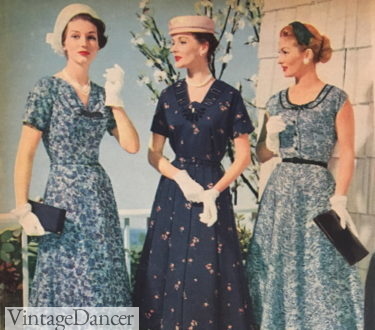
1950s, gloves were an elegant accessory and practical protection from germs
Vintage gloves were also a protection from disease. Contagious disease was the ruin of lower and middle class families. Upper classes feared catching an illness when out in public. Even with gloves on, there was very little touch involved, including close family members. Wearing gloves even to greet one’s guests at home served as protection from the outside world.
Gloves were never removed unless a woman was eating or responding to nature. Frequent hand washing around these two activities was done before putting gloves back on. With the heightened fear of germs, gloves became more than an accessory; they were a necessity for a healthy life.
Finally, gloves also covered the body up. Modesty was very important in clothing and dress, especially in the early teens and twenties, when gloves were one more way for a woman to remain covered while being uncovered in short sleeved dresses. To bare skin was shocking and un-ladylike.
Even in the evenings, when fashion allowed more flirting with exposed skin, young women wore over-the-elbow gloves, making it possible for arms to remain decently covered. Shorter mid forearm length gloves could be worn during the day only if her dress or blouse had long sleeves to overlap the gloves.
- 1914 long silk gloves
- 1910s long gloves cover her arms
1900-1910s Gloves
Learn about Victorian era gloves (1840s to 1900).
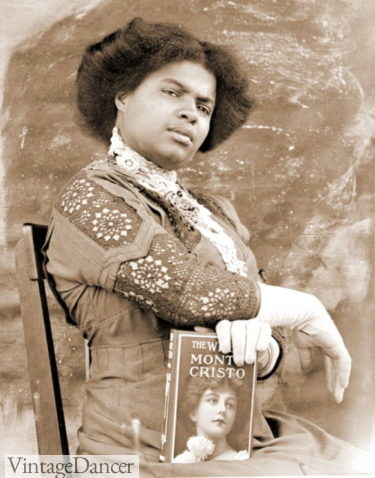
Women with white daytime gloves
In the early 1900s, vintage gloves were worn everywhere. As mentioned above, the length of glove determined what other garments she was wearing. During the day, kid leather suede also called mocha and cotton lisle were worn in mid-forearm lengths. They fit tight and thin, buttoning from the wrist up to the top of the glove. Many had fine embroidery stitched onto the top of the glove or all over. Fancy gloves were lined in silk and winter gloves were lined in wool or fur.
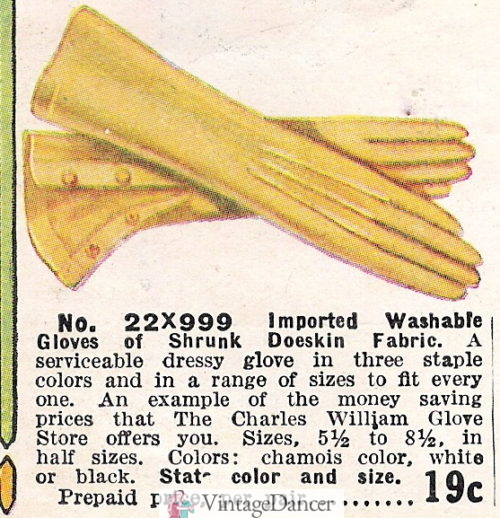
1914 chamois color doeskin gloves
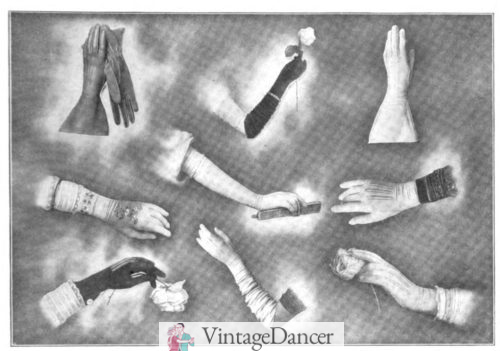
1905 fancy day gloves, gauntlet , evenings
There were specialty gloves for wedding clothes and even driving. Gauntlet gloves were the best style for driving cars, driving horses, or other potentially dirty work. The gauntlet cuffs protected the sleeves of her dress or coat.
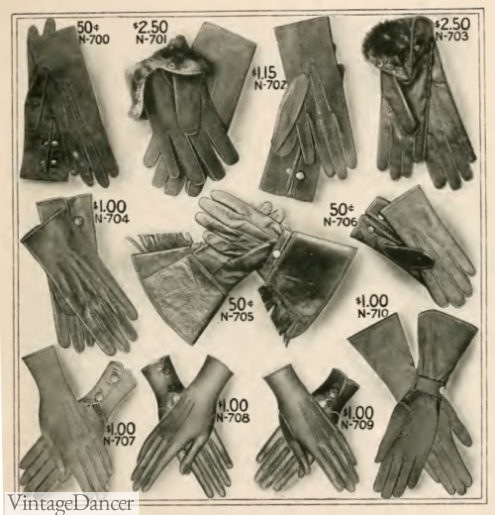
1915 gloves for day, evening, driving and winter
Popular colors were tan, brown, black, white, red, grey, navy blue, cream, and green. Various shades of these existed to coordinate with the colors of her clothing. If gloves could not be matched perfectly, a light shade of tan mixed well with most outfit colors.
As clothing colors lightened, so did glove colors. Pastels grew increasingly popular, including the biggest fad for lavender, which replaced white as early as 1900.
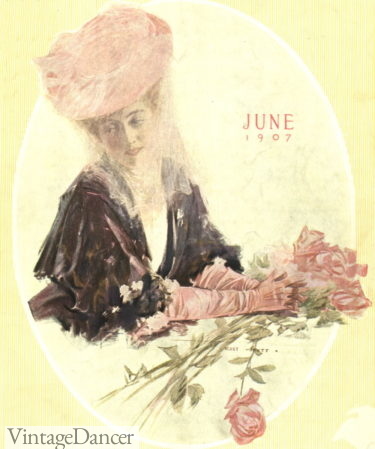
1907 rose pink gloves with matching hat
Gloves were sized based on the circumference of her palm, and the arm width was adjusted accordingly. Upper class women had gloves custom made along with shoes. For working women who had thick hands but skinny arms, the awkward fit of her store bought gloves was a sign of her lower class.
During the evening, longer gloves – from 12 to 20 buttons, reaching all the way to the bicep – were appropriate in kid leather, suede, or silk.
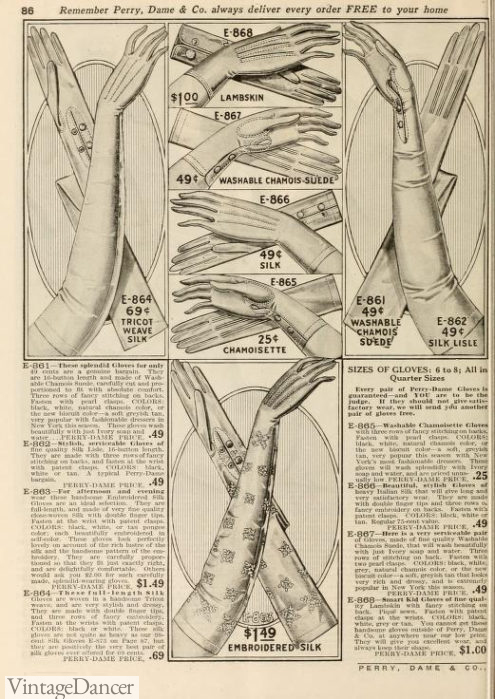
1915 shorter day (middle) and longer evening gloves (outer)
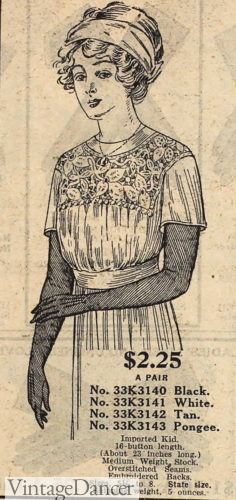
1912 long evening gloves
Gloves, lavishly decorated with lace and embroidery before, became very plain during war time. When WWI hit, supplies of leather went to the war effort and the price of gloves soared. Simple washable gloves were preferred over fancier fabrics.
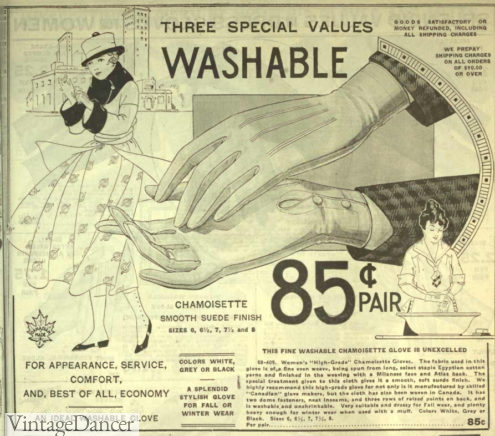
1918 washable gloves
1920s Vintage Gloves
Women continued to wear mid-forearm length gloves after the first World War, but they were certainly on the decline. It was also a declining trend to wear gloves all the time. The new fad for sun tanned skin meant that women didn’t need to cover up completely.
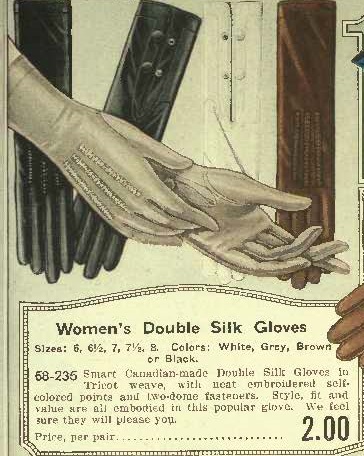
1920 silk gloves- black, white, brown or grey
Colors were dyed to match either a dress or accessories for the upper class, or were a plain, neutral color for the lower classes such as black, brown, grey, or white. Popular fabrics were soft kidskin (goat), capeskin (sheep), suede, silk, and cotton.
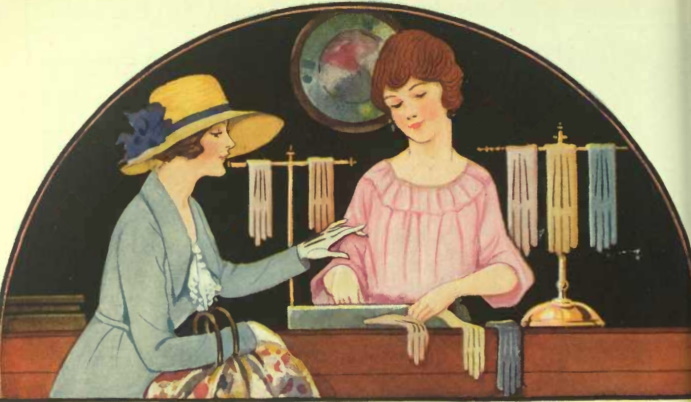
1922 glove shopping- many more pretty colors!
In summer, gloves were hardly ever worn, while winter called for warm leather or hand knit gloves and mittens lined in fleece, knit, or fur.
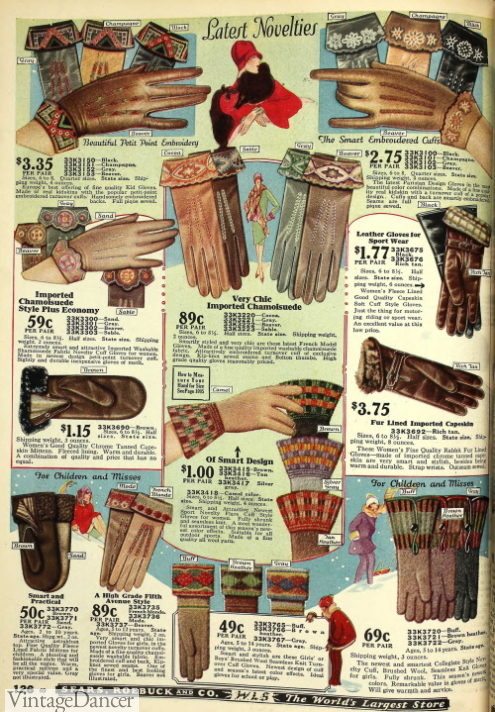
1927 winter gloves with embroidered cuffs, fur lined or knit
Certain occasions in semi-formal dress (tea parties, visiting, traveling) called for women to wear gloves in all seasons. They could be an open mesh or light cotton for summer and leather, silk, lisle, rayon, or wool in winter.
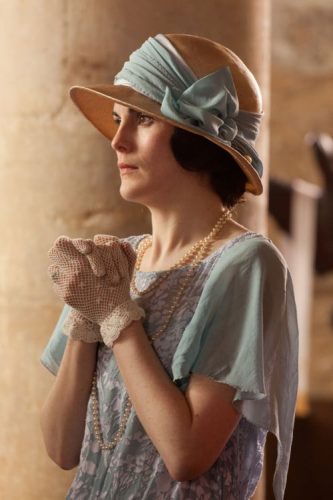
Early 1920s, white mesh gloves were ideal for semi formal summer wear (Downton Abbey 2012)
Some women continued to wear button gloves, but the gauntlet was the more stylish choice (a gauntlet is a large cuff that is wider than the glove, so only the part that covers the hand is very tight-fitting). Elasticized panels in the wrist of gloves also allowed them to be pulled on instead of buttoned.
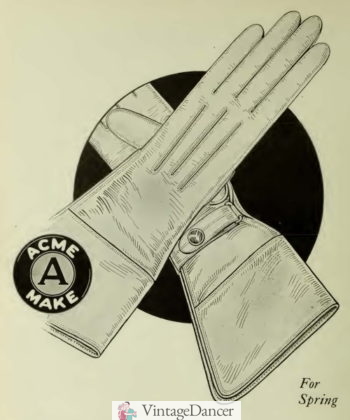
1920 gauntlet gloves
By the mid 1920s, the large gauntlet glove shrunk to a smaller French cuff. They then folded back onto themselves around 1927. The cuffs were highly decorated with embroidery, contrasting fabric, knitted designs, lace edging, and various shaped edges. The cuffs were quite colorful and very fun for the times.
- 1926 gloves
- 1926 gloves and mittens
The size of cuff gradually reduced to a thin band by 1928, and by 1929 were disappearing. Instead, edges could be scalloped or back to the plain edge of the early ’20s.

1928 gloves with small cuffs
In the evenings, long opera length gloves that were worn up to or over the elbow continued. They were made of silk or rayon satin in white, brown or black. It was not required, but the wealthier classes usually opted for this traditional look. The fad for long gloves went out when sleeveless evening dresses came in. Now women were encouraged to show off bare arms while dining and dancing to jazz music.
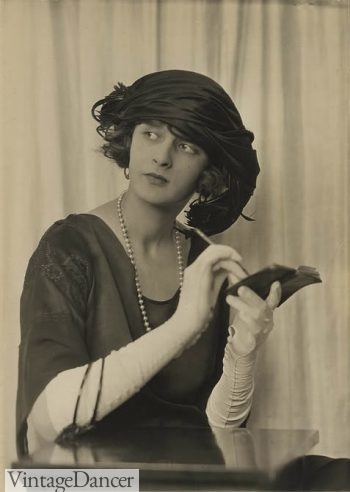
1922 Long white opera gloves with formal attire
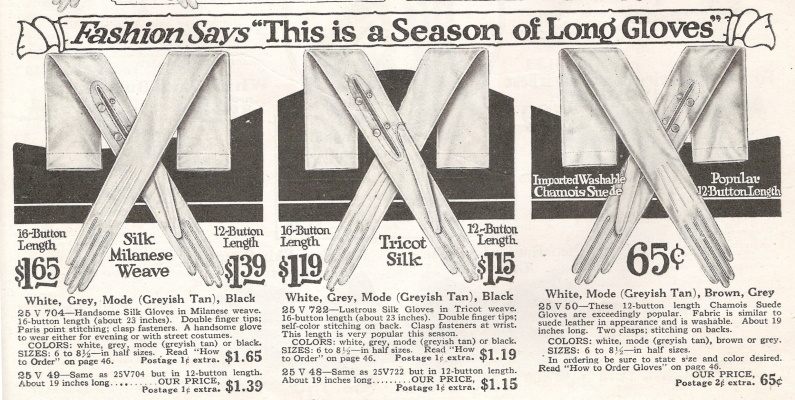
1922 long evening gloves
Gloves during the daytime remained on at all times unless a woman was doing something that could dirty her gloves, such as eating, smoking, or applying makeup. This includes drinking tea, which many movies ignore, filming women daintily sipping tea with fully gloved hands.
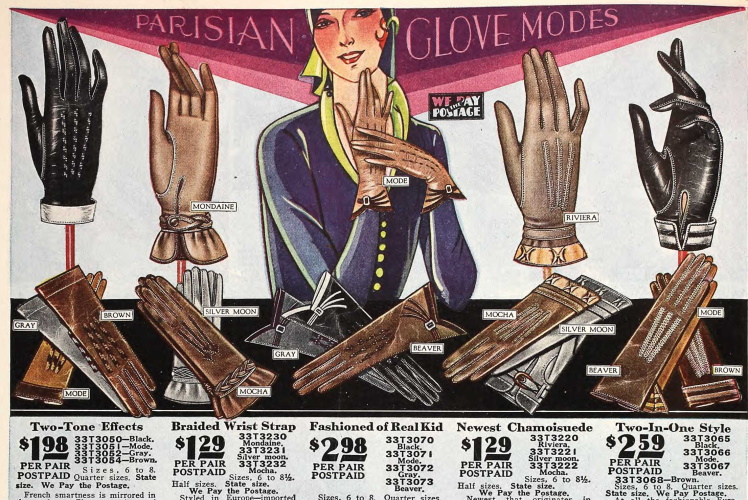
1929 gloves- plain colors, fancy cuffs and edges
1930s Vintage Gloves
For very formal wear, gloves continued to be abandoned in the 1930s. ‘The more skin the better’ was the attire of the evening. A few exceptions were worn by top designer Schiaparelli, who returned to the 20 button opera glove for some formal looks. Hollywood loved how dramatic they looked in film, too. Some designers paired elbow length, gauntlet, or short cuffed gloves with evening gowns (matching, black, or white). For weddings, white long gloves were worn for modesty in church.
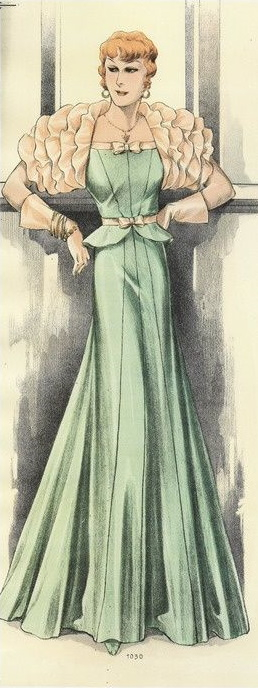
Evening gown with gauntlet gloves
Leather gloves continued to have their place for dressy occasions, city life, sport, and manual labor, but for most daily wear, fabric gloves were much more practical and affordable. Made of cotton or rayon they were thin, washable, and dyeable for more color choices.
- 1931 gloves, rainbow mittens
- 1933 winter gloves
The fold down cuff of the late ’20s unfolded for a gauntlet cuff again with large shaped edging such as scallops, petals, and diamonds. The cuff designs were as elaborate as the details found on dresses, shoes and handbags. Bows, buttons, and pintucks were arrange with equal care, adding to the unique designs the thirties were known for.
Elastic at the wrists removed the need for buttons, unless purely decorative.
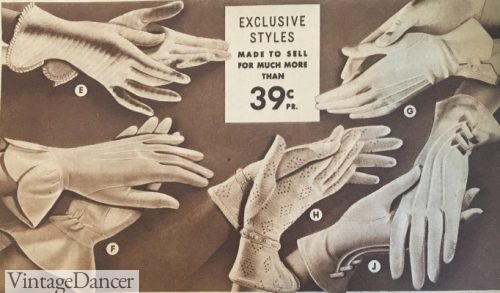
1937 gauntlet gloves in white both fabric and crochet mesh
Less fancy gloves were a little shorter in suede leather or cotton cloth with minimal decoration. During hard times, these were the most affordable, besides home knitted gloves and mittens.
- 1934 gloves
- 1936 gloves
In the summer, homemade crochet gloves in white were breathable and affordable. They often matched crocheted purses, belts and hats, too. The gauntlet design applied here as well.
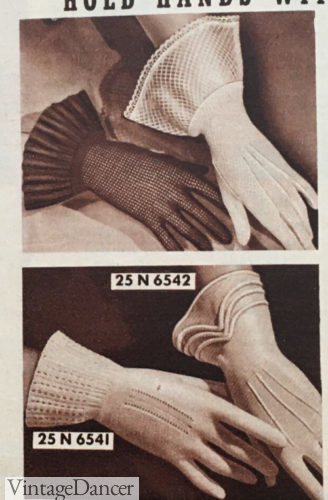
1937 mesh gloves
The color of the gloves matched the other accessories. They did not need to match the dress. To save on expense, most women had black, brown and white gloves in their wardrobe with coordinating accessories. These were the most practical for any outfit.
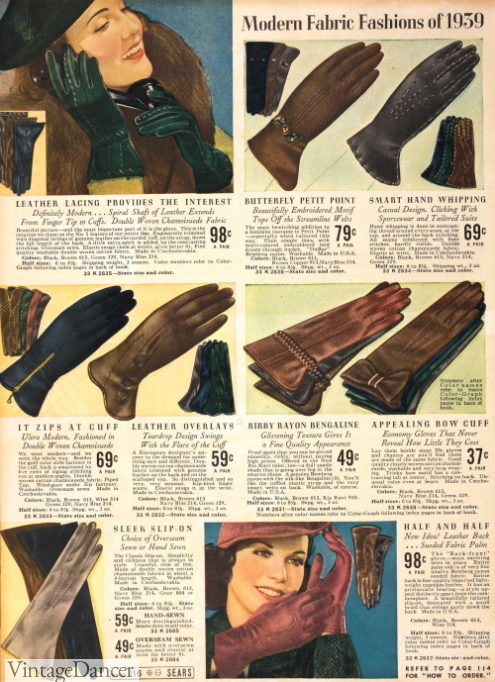
1938 gloves
1940s Vintage Gloves
During the ‘40s and WWII, gloves were rationed – women had to use precious ration coupons to get them, and so they became a somewhat frivolous accessory. Women worked a lot during the war, both in and outside of the home, and fancy dress gloves were simply not practical.
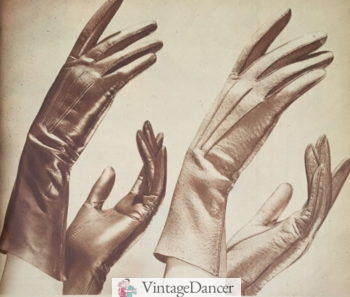
1942 leather gloves
At the same time, women needed a bit more color in their drab wardrobe to encourage cheerfulness. Matching gloves, purses and hats in bright hues (red, green, blue) was one way to add that pop of color.
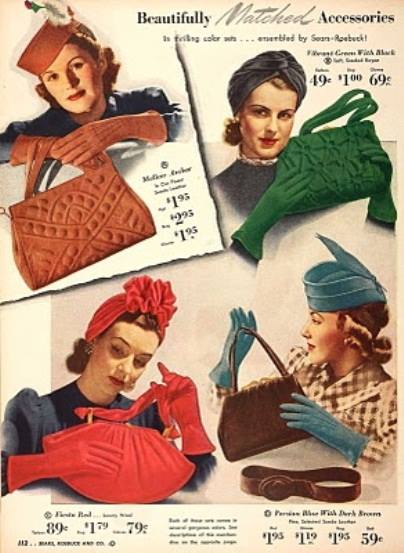
1940s matching purses, gloves, hats
Daytime dress gloves were usually made from leather or suede in dark, neutral colors like navy, tan, brown, and black, although dark red and green were also used. White was also common for those who could keep them clean. Fabric gloves made of cotton or rayon were still the most affordable and cool in summer.
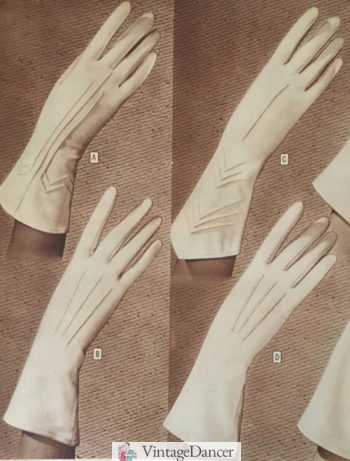
1942 white rayon gloves
The gauntlet style narrowed down to a slight taper over the mid-arm and fancy cuffs, trim, and decorations disappeared. Elbow-length leather and fabric gloves were worn pushed down towards the wrists for a more stylish look, especially with suits. This ruched effect mimicked the ruching common on women’s dresses and many purses, too.
Basic glove design changed little over the decade. Lengths shortened a tad in the later years. Decorations also reduced, choosing color as the statement going forward.
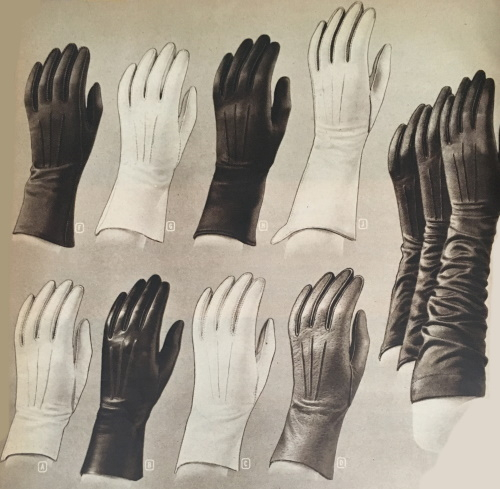
1948 leather gloves- black, white and tan
In the 1940s, vintage gloves were coordinated to a hat, purse, dress or suit, not necessarily to multiple accessories. Having a colorful glove that stood out from the rest of the outfit was very chic in the late 1940s.
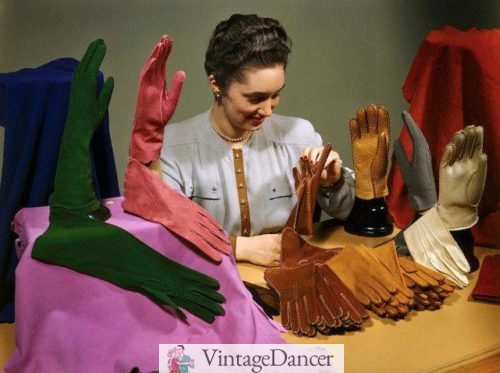
1947 colorful gloves
Vintage gloves weren’t even necessary for evenings anymore, but women wore them more at night, sometimes attempting to make a daytime dress fancier for an evening occasion. White or ivory wrist-length kid leather gloves were a popular choice, and shirred stretch silky or velvet rayon in a variety of colors amped up the glamour.
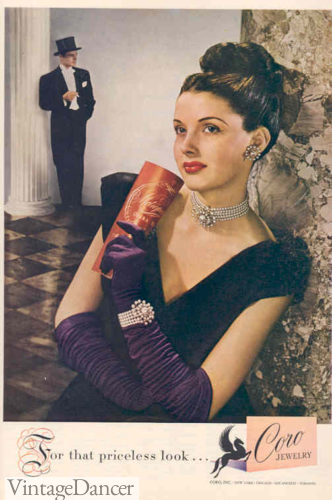
1946 purple evening gloves standout against a black velvet gown
1950s Vintage Gloves
Gloves saw a resurgence during the ‘50s, when clothing became ultra-feminine and formal after the war. Accessories were very important, and a matching hat, bag and gloves were required to finish off an outfit.
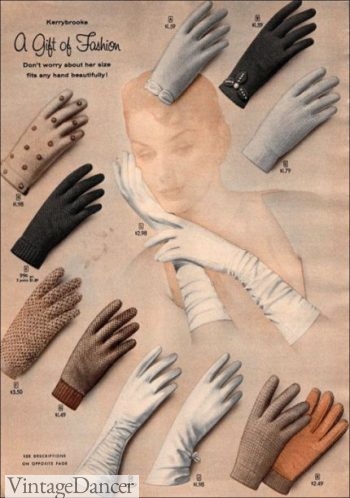
1950s short gloves
Most women wore gloves when out in public during the day, especially in the first half of the decade. Daytime gloves were wrist-length in leather, suede, cotton, nylon, and wool jersey, in either neutral colors or plain white cotton. Jackie Kennedy wore wrist length white gloves for most of her public appearances. She was a model for the decade as to how women should dress.
- 1957 short white gloves were worn with nearly every dress
- 1957 mid arm ruched gloves
Winter saw black leather gloves, as well as textured brown tweed gloves, make a steady appearance. Heavy winters required knitted gloves or fur-lined leathers. In summer, cotton or crochet mesh gloves were the coolest option.
Gloves took note from all the previous decades and came in a number of other lengths, cuts, and colors. The scalloped gauntlet remained common as well as long plain gloves. Button details, bows, embroidery, and ruffles adorned many day styles. Peach, pink, and baby blue were all lovely colors for spring. Sheer gloves were also popular, but hardly practical.
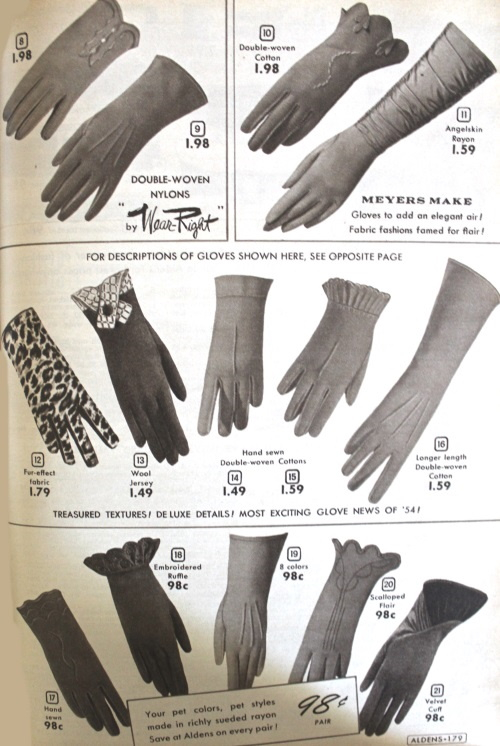
1953 glove varieties
My collection of vintage gloves from the 1950s feature scallop edges and eyelet embroidery as well as plain long leather in white, ivory, pink, nude, and black:
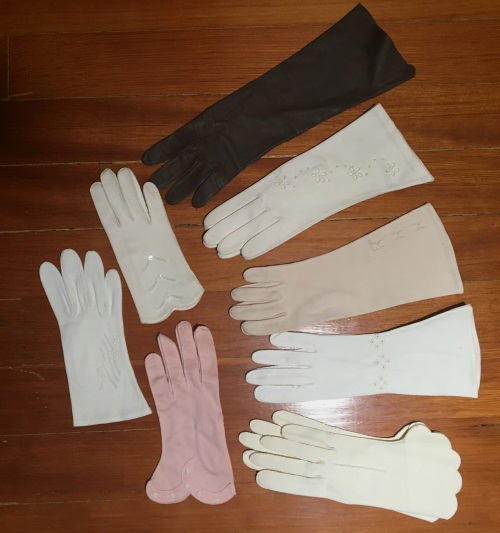
My 1950s glove collection
Gloves also came in newer synthetics like nylon. Despite the durability and wash friendliness, they did not breathe well and were usually passed over for white cotton gloves. Most women had drawers full of white gloves, ready to be tossed out once they became too dirty to clean.

1957 cotton gloves in short to long lengths
Glove designs were very pretty, matching that of other accessories. Simple gloves had a short ruffle or lace trim around the wrist. Summer gloves may have had laces or perforations added to keep them cool. My favorite technique was an embossed pattern on the gloves such as leaves, flowers, or an artistic modern design.
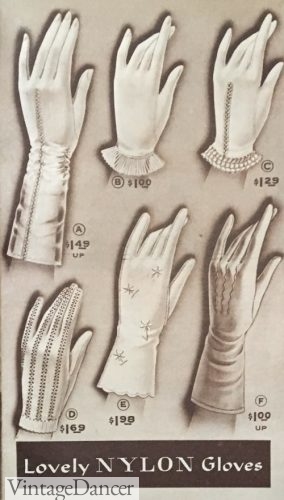
1957, nylon gloves for summer
Evening gloves were worn, too – elbow-length or shorter mid-arm length – in satin or nylon, of course matching the dress. Big sparkly bracelets were often worn over the top. Evening gloves dyed to match a formal dress were ideal for long gloves. Alternatives were sheer net or short lace gloves in a harmonizing color.
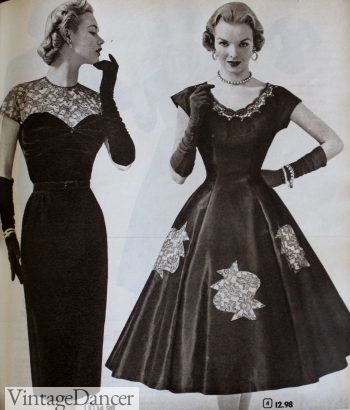
1950s formal dress with long gloves and sparkling bracelets
1960s Vintage Gloves
In the ‘60s, women didn’t feel like they had to wear gloves at all, and most didn’t for any reason.
In the early years, the use of gloves was identical to the 1950s. Mostly white, very short, and undecorated. Longer gloves for the evening were still an elegant option.
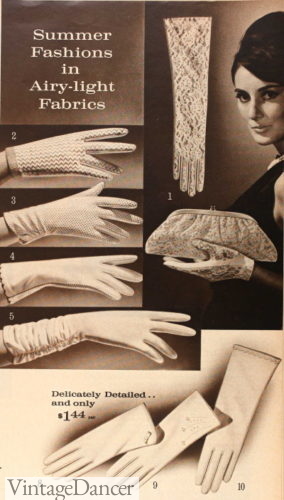
1964 summer gloves- lace, cotton, ruched, long and short
As the years moved on, there was a wave of interest in pastel colored dresses, so naturally, gloves came in pink, yellow, blue, and green, too. In fall or winter, colors embraced earth tones – namely light tan, moss green, black, and nude.
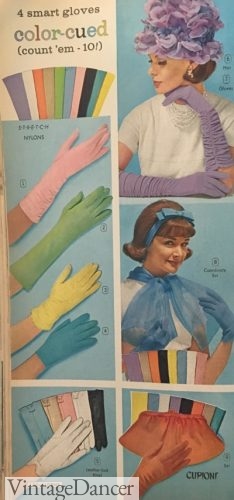
1964 pastel colors were in style
Gloves almost always coordinated with the dress, not the accessories. There were exceptions where a pop of colored gloves was worn to spice up an otherwise plain look.
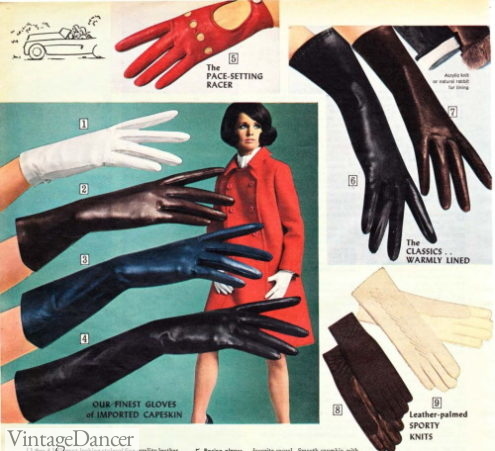
1968 long leather gloves return
When the mod look became popular, gloves emerged with more personality. Cutouts, buttons, and contrast trim updated them from the plain old ladies’ style. The latest craze was for synthetic fabrics like stretchy nylon and shiny vinyl. They didn’t breathe well, but the shine to them was new and very modern for the Space Age.
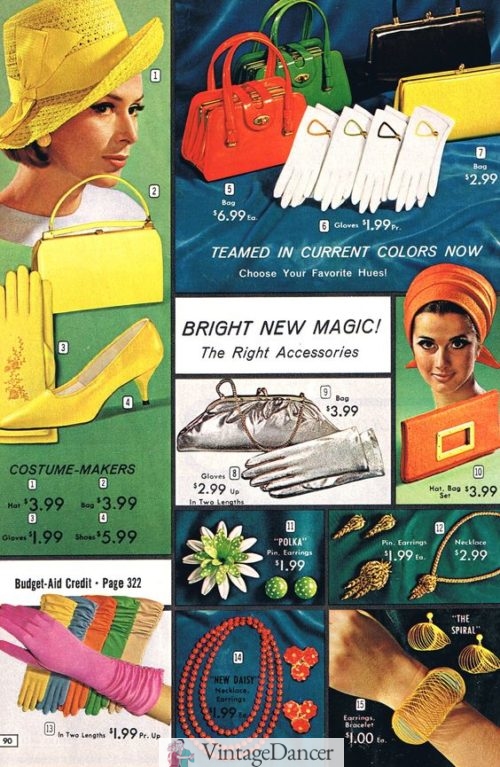
Mod colors and accessories
Looking at fashion pictures, by 1967, women didn’t wear gloves but they carried them in hand. They were now a fashion accessory without a purpose! By the 1970s, vintage gloves were gone from fashion except in winter, where they were required for warmth.
Just like today, dress gloves could be worn for special occasions and sportswear but that was about it. Women had had enough.

My 1960s mod gloves with red and blue trim
1970s and 1980s
By the 1970s women’s gloves were nearly extinct. However in fall and winter they were still worn to keep out the cold. The latest trends involved men’s style sport gloves such as leather or mesh driving gloves, golfing gloves, or traditional riding gloves in leather, suede, tweed and wool. Most were brown or black neutral colors.
- 1972 winter sport and knit gloves
- 1976 sporty driving gloves
The 1980s saw a bit of a comeback for lace, mesh and satin gloves when wore with sophisticated/wealthy woman styles. They reflect similar styles found in the Victorian era and its more recent revival in the 1950s. The tea party hat, purse and gloves set were worn for many summer soiree events and weddings.
The pop stars and rock stars of the 80s frequently wore the fingerless mesh, lace or leather glove for their stage costumes. Many teens copied the look.
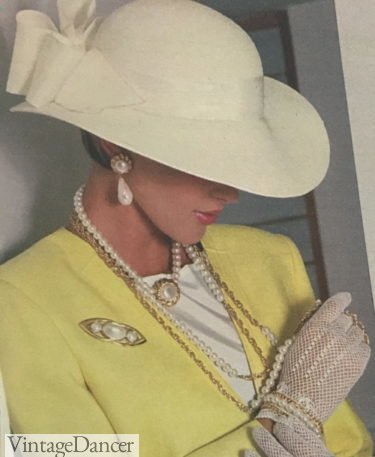
1985 hat and gloves return
Will dress gloves come back in fashion again? Only time will tell….
Vintage Style Gloves
Adding a pair of gloves will add that extra bit of oomph and authenticity to any outfit. Shop here for new vintage inspired gloves in all lengths and colors.
Debbie Sessions has been teaching fashion history and helping people dress for vintage themed events since 2009. She has turned a hobby into VintageDancer.com with hundreds of well researched articles and hand picked links to vintage inspired clothing online. She aims to make dressing accurately (or not) an affordable option for all. Oh, and she dances too.
